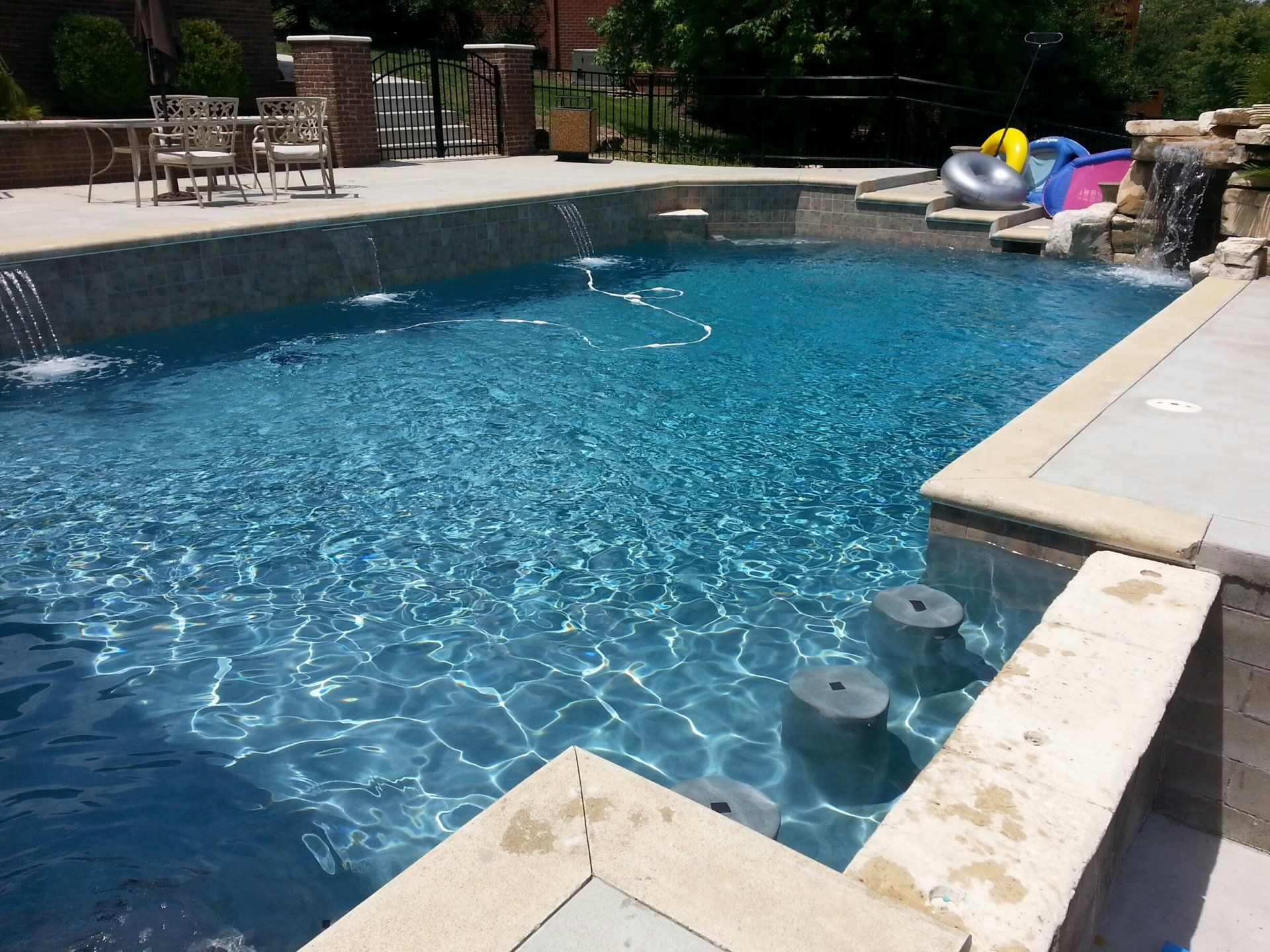What Is a Gunite Pool?
After a long winter, what better place to enjoy the summer sun than in your own backyard, lounging around a beautifully custom-designed and custom-built Gunite Pool.
You have probably heard of a gunite swimming pool if you are a lover of pools or enjoy the popular shows of custom gunite pools being built. Gunite pools have always been the go-to construction method for commercial spaces and custom homes due to their durability and limitless customization options.
Most people have heard of a gunite or shotcrete pool but don’t know what they are, how they are built or the differences between the two. gunite and shotcrete are pneumatically placed concrete. They are both made of:
- Fine sand
- Cement
- Small pea gravel
- And fly ash
Gunite is a dry mix, and water is added at the nozzle as its being sprayed onto walls. The high pressure air both helps spray the gunite and helps the mixture dry very hard and dense.
Shotcrete has the same ingredients but come to the site as a premixed concrete. It is also sprayed with high pressure air to help build, stack and shape the new pool walls, floor and features.
No matter if your builder is using the wet or dry method of pool installation, it will most often be referred to as a gunite pool as that is the term most people are familiar with. Both methods of installation are equally strong and durable.
How Is a Gunite Pool Constructed?
Gunite pools follow a standard workflow that includes design, the actual build and adding finishing touches. Let's walk through the entire process:
- Decide on Design: Decide on a design that is right for you and your family and friends that you’ll have over for get togethers.
- Form and Dig Pool: Once a design is agreed upon your builder will lay out the shape of the pool on the ground by staking it out for the digger to come in and dig the hole for the pool. Next a four inch layer of gravel will be put into the bottom of the hole to help keep the bottom dry.
- Run Plumbing: Next the plumbing go’s in. you’ll have your skimmers, main drains and return line for the filtration of the pool installed. Gunite pools are always and if not should always be plumbed using schedule 40 PVC piping.
- Place Rebar: After the plumbing is in the rebar go’s in. Rebar is a steel rod. it comes in many sizes but for most normal Gunite pools 3/8” and 1/2” diameter rebar is used. Spaced one foot on center at an minimum in order to provide a strong structure.
- Apply Gunite Application: Once the rebar is in its time to apply the Gunite. It takes Highly trained and experienced employees to spray the Gunite onto the rebar and the to shape the Gunite pool shell.
- Place Pool Tile: After the Gunite shell is in place your halfway there to having a new pool. Next comes the installation of the frost proof pool tile to go around the top six inches of the perimeter of the pool. There are many beautiful colors and tile to choose from. This process also takes a skilled professional.
- Install Pool deck: Now its time for the installation of your pool deck. You can choose a concrete pool deck. This can be stamp concrete which simulates natural stone or it can be a broom finish concrete which is more affordable of the two. You may also choose to go with a pool coping and pavers such as travertine to add more natural beauty to you project.
- Apply Pool Plaster: After the pool deck is complete your ready for the interior finish of your new Gunite pool. The shell of a Gunite pool is rough and an interior plaster will need to be chosen and applied to the entire exposed surface of the Gunite walls and floor. This is to make the surface smooth to the touch and gives the pool it’s water tight seal. Marcite or marble lite as some people refer to it, is a 2:1 mixture of white cement and crushed marble. It is troweled on to the pool surface 3/8" to 1/2" inch thick and troweled to a smooth surface providing a durable long lasting surface. If Marcite is used for your final interior surface than the professionals that applied it will start the water the same day the plaster is applied.
Other Pool Finishes
There are many other pool finishes on the market today and most consist of exposed aggregate finishes.
One of the most commonly used exposed finishes in the Cincinnati area is Diamond Brite. There are many colors to choose from and you should be thinking about the color you want your water to be when you pool is filled up and running. If You want your water to be a light sky blue color than you will be happy with Marcite or blue, cool blue and any of the other Diamond Brite that have no dyes added.
If you want your water to be more of a Mediterranean deep dark blue, than you need to consider one of Diamond Brite Water colors like cobalt or steel blue.
The Diamond Brite is applied the same way as Marcite. It’s troweled on 3/8" to 1/2" inch thick and troweled to a smooth finish. After the Diamond Brite is finished the applicators will have to come back the next day to acid wash pool to expose the colored aggregate in the Diamond Brite.
Once the acid wash is complete the water can be started. Once pool is filled normally half way up the pool tile. Your pool builder can come back adjust chemicals and start up your filtration system.
Your Gunite pool is now complete, ready to swim in and enjoy for generations.


